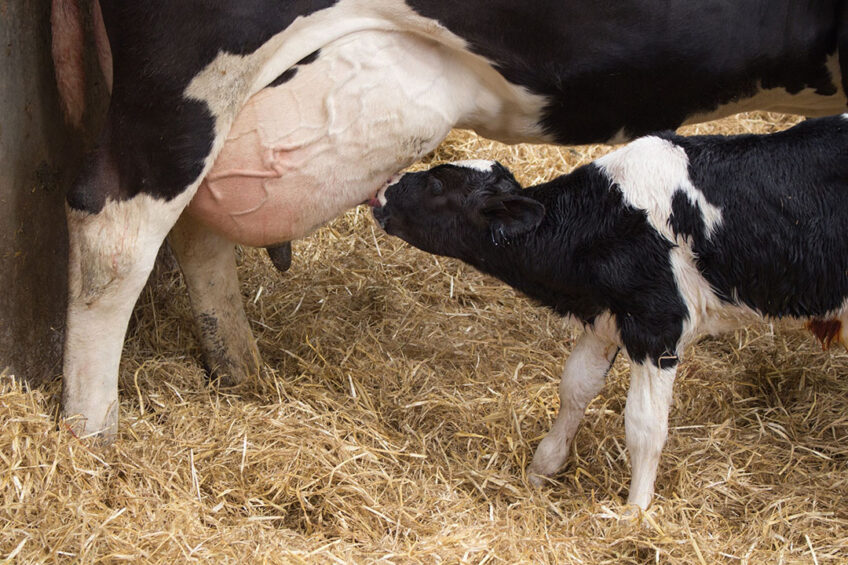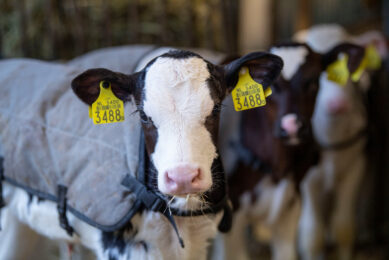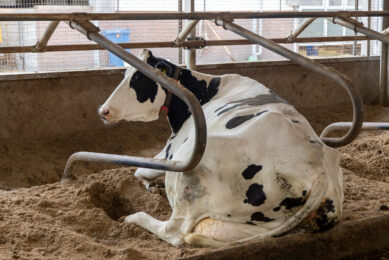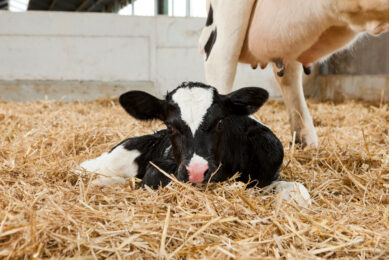How much saleable milk is lost in a cow-calf contact system?

Although beneficial in many respects, cow-calf contact systems introduce additional challenges to collecting reliable data on milk production, which is important to assess individual cow efficiency and dairy farm profitability. In their study, researchers from the Swedish University of Agricultural Sciences estimated the loss of saleable milk when housing cows and calves together in an automatic milking unit.
In modern dairy production, the practice of keeping cow and calf together, or cow-calf contact, is attracting interest from farmers as well as consumers worldwide due to welfare and ethical benefits. However, a major source of concern for farmers considering a cow-calf contact system is the loss of saleable milk and the subsequent decrease in revenue for the farm. Besides the ability to weigh calves before and after each feeding, the amount of saleable milk lost due to calf suckling is still practically challenging to measure. Studies show that the loss of saleable milk in cow-calf systems can have several explanations. In addition to milk consumed by the calf, it is possible that saleable milk yield becomes limited due to disturbed milk ejections leading to decreased milk removal from the udder during milking. Calves are also indirectly capable of lowering cow energy intake, limiting the milk yield for cow-calf cows. The current research aims to understand trade-offs in cow-calf contact systems based on the loss of saleable milk.
The cow-calf contact system
In this study, cows and calves were kept together full-time until the calves were about 127 days old (cow-calf contact group). In the (control cows group), cows were separated from their calves within 12 hours of birth and then kept in the same unit as the treatment cows but with no access to either their own calves or calves from the cow-calf cows. The Swedish Red and Swedish Holstein breeds in first parity or higher were equally divided into these 2 groups. The study was conducted at the Swedish Livestock Research Centre of the Swedish University of Agricultural Sciences.Milk yield loss estimation
A first step in evaluating the effects of cow-calf on lactation milk yield is to provide accurate estimates of the total amount of milk that the cow produces, as well as during the time with calf contact. Because determination of milk intake by the calf can be challenging and the amount of milk consumed varies between calves, an estimation of true total milk yield is not as straightforward in cow-calf systems as it is in conventional milk production. Although several methods are available to estimate milk intake in the offspring, such as weigh-suckle-weigh and a deuterium oxide marker, these methods have been developed to estimate milk intake in the young rather than milk production in the mother. In addition, both methods can be stressful and cause disturbances to mother-offspring interactions, and are further complicated by allosuckling, making them unfeasible in many cow-calf systems. In this study, the researchers used 2 different methods to estimate milk loss in both groups: (1) Milk yield prediction through the lactation curve estimation model, and; (2) Milk yield prediction using energy intake data.Saleable milk loss
Overall, results showed that control cows (without calves) were estimated to produce more milk than cow-calf cows, independent of which method was used. It was also shown that the average saleable milk yield loss for cow-calf cows was 11.3 kg/d using the lactation curve method and 7.3 kg/d using the energy intake method. On methods used, the method utilising energy intake data was more accurate in estimating milk yield compared to the lactation curve estimation model, based on the lower deviation from actual production data from control cows. On the other hand, the lactation curve method overestimated saleable milk yield in control cows by an average of 3.4 kg/d, indicating that the true milk yield for cow-calf cows could also be lower than estimated by this method. The loss of milk in the cow-calf system was related to milk suckled by the calf as well as possible production losses due to poor milk ejection stimulated by suckling as reported in other studies. Pertaining to the estimation methods, the researchers stated that although the energy intake method was more accurate, collecting detailed energy intake data per individual cow requires additional effort and equipment, which is not always feasible on commercial farms. Therefore, further research is needed to improve milk loss estimation at commercial farm level to better understand trade-offs in cow-calf systems.Causes of milk loss in cow-calf contact systems
The current study did not set out to explicitly explain the reasons for the lower yield of saleable milk in cow-calf cows as they recommended that these causes should be investigated further. However, they pointed to previous studies for possible explanations. For example, other studies found that the amount of time spent with calves affects saleable milk yield differently. According to the researchers, besides the loss of milk through calf suckling, they mentioned that other findings indicate a less efficient milk ejection response to machine milking in cow-calf cows, which is attributed to insufficient oxytocin release during milking. Incomplete or infrequent milk removal can have a negative effect that carries over to several milkings, potentially leading to lower long-term milk yields in cow-calf cows.Conclusions
It was concluded that a considerable amount of saleable milk is lost in the cow-calf system in a robotic milking system. Modelling milk yield based on the lactation curve model overestimates the amount of saleable milk yield. The energy intake method is more accurate in predicting milk yield as it correlates better with actual production data but lacks practical feasibility on commercial farms. The researchers proposed that the models be tested with larger numbers of animals for validation and that further research should be conducted on milk yield variations among different cow-calf systems. “It should also be investigated how including pasture data would affect the accuracy of the models while investigating some of the assumptions made in the current study,” they said. However, for research purposes, they recommended using the energy intake method for the estimation of milk yield loss in cow-calf systems. The original article is by Mikhail Churakov, Hanna K. Eriksson, Sigrid Agenäs, and Sabine Ferneborg, 2023, and entitled ‘Proposed methods for estimating loss of saleable milk in a cow-calf contact system with automatic milking’.Join 13,000+ subscribers
Subscribe to our newsletter to stay updated about all the need-to-know content in the dairy sector, two times a week.










